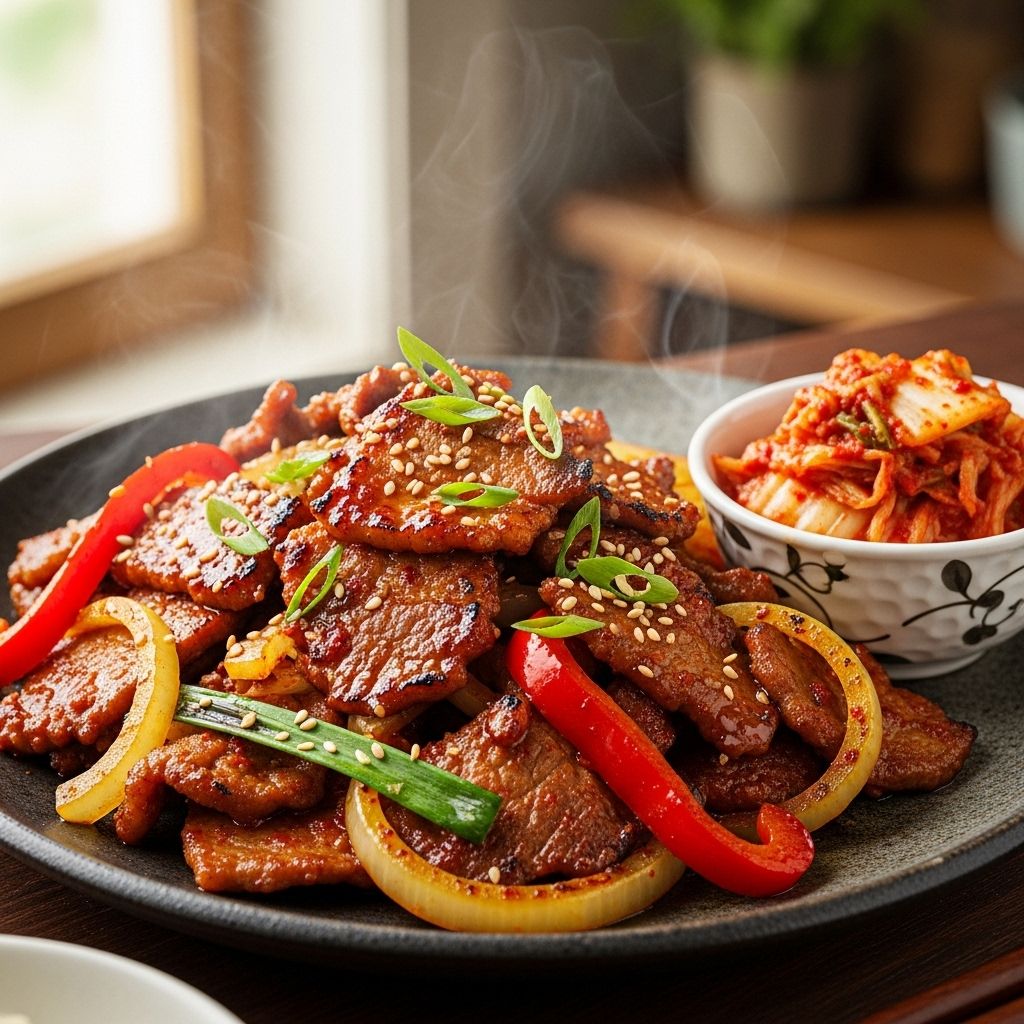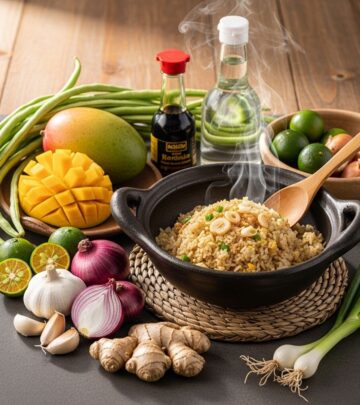Spicy Korean Pork Bulgogi Recipe: Ultimate Flavor Guide
Master the art of creating authentic Korean spicy pork bulgogi with this flavor-packed recipe

Image: HearthJunction Design Team
Introduction to Spicy Korean BBQ-Style Pork
Spicy Korean BBQ-style pork, known in Korea as Jeyuk Bokkeum (제육볶음) or Dweji Bulgogi (돼지불고기), is a beloved dish featuring tender slices of pork marinated in a vibrant, spicy sauce. This dish exemplifies the bold flavors of Korean cuisine with its perfect balance of heat, sweetness, and umami. Unlike its beef counterpart which typically uses a soy sauce base, pork bulgogi embraces the fiery kick of gochujang (Korean chili paste) to create a dish that’s both satisfying and addictively spicy.
The popularity of this dish extends beyond Korea’s borders, becoming a favorite for spicy food enthusiasts worldwide. Whether you’re cooking it on an outdoor grill during summer gatherings or preparing it as a quick weeknight stir-fry, this versatile dish delivers impressive flavors with relatively simple preparation.
The History and Cultural Significance
Bulgogi, which literally translates to ‘fire meat,’ has been part of Korean culinary tradition for centuries. While beef bulgogi may be more internationally recognized, pork bulgogi holds its own special place in Korean households and restaurants. The spicy pork version became particularly popular in the mid-20th century as gochujang became more widely available.
Today, spicy pork bulgogi is considered a staple in Korean barbecue restaurants and home cooking alike. It represents the Korean love for communal dining, where multiple side dishes (banchan) accompany the main protein, creating a feast that brings people together. The dish perfectly showcases the Korean approach to balancing flavors—combining spicy, sweet, savory, and umami elements in one harmonious dish.
Essential Ingredients for Authentic Flavor
Creating authentic spicy Korean BBQ pork begins with selecting the right ingredients. Each component plays a crucial role in developing the complex flavors that make this dish so special.
For the Meat
The foundation of excellent jeyuk bokkeum starts with choosing the right cut of pork. While the dish can be made with various cuts, pork shoulder or pork butt with some fat marbling works exceptionally well. The fat content helps keep the meat tender during cooking while adding richness to the overall dish. Some recipes even incorporate sliced pork belly to intensify the pork flavor.
When preparing the meat, it should be sliced thinly (about 1/8 inch thick) for quick cooking and optimal marinade absorption. Many Korean markets sell pre-sliced pork specifically labeled for bulgogi, saving preparation time. If slicing at home, partially freezing the meat for about an hour makes achieving thin, even slices much easier.
The Signature Marinade
The heart of spicy Korean BBQ pork lies in its distinctive marinade. Here are the key ingredients that create its unforgettable flavor profile:
- Gochujang (Korean Chili Paste): This fermented chili paste provides the backbone of flavor with its complex sweet, spicy, and umami notes. For authentic spicy pork bulgogi, use about 6 tablespoons.
- Gochugaru (Korean Chili Flakes): These add additional heat and a slightly smoky dimension. Adjust the amount (typically 1-2 tablespoons) according to your spice preference.
- Soy Sauce: Contributes savory depth and salt to balance the spiciness.
- Sugar: Balances the heat with necessary sweetness and helps with caramelization during cooking.
- Fresh Garlic and Ginger: Essential aromatics that provide characteristic Korean flavors.
- Sesame Oil: Adds a nutty fragrance and richness to the marinade.
- Rice Wine (Mirim): Brings subtle sweetness and helps tenderize the meat.
- Toasted Sesame Seeds: Provide texture and nutty flavor.
Step-by-Step Preparation Method
Creating this flavorful dish involves several key steps, from preparing the marinade to achieving the perfect cook on the meat.
Preparing the Marinade
Begin by combining all the marinade ingredients in a mixing bowl: gochujang, gochugaru, soy sauce, sugar, minced garlic, ginger paste, rice wine, sesame oil, toasted sesame seeds, and black pepper. Mix thoroughly until you have a smooth, uniform paste. The vibrant red color of this marinade promises the bold flavors to come.
Marinating the Meat
Place the thinly sliced pork in a large bowl, ensuring the slices are separated. Pour the prepared marinade over the meat and mix thoroughly to coat each slice evenly. Using food-safe gloves makes this process much cleaner and easier. For maximum flavor development, allow the meat to marinate in the refrigerator for at least 30 minutes, though marinating for 2-4 hours or even overnight will result in more intensely flavored meat.
Cooking Techniques
Spicy Korean pork bulgogi can be prepared using several cooking methods, each offering slightly different results:
Stir-Frying Method
- Heat a large skillet or wok over high heat and add about 2 tablespoons of oil.
- For enhanced flavor, add 2 teaspoons of sugar to the hot oil and let it caramelize slightly.
- Add chopped green onions or Asian leeks and stir-fry briefly to infuse the oil.
- Add the marinated pork along with sliced onions, spreading it in a single layer if possible.
- Cook the pork for about 3-4 minutes, stirring occasionally, until the meat is fully cooked and slightly caramelized at the edges.
Grilling Method
- Preheat your grill to medium-high heat.
- Place the marinated pork slices directly on the grill or use a grill basket if the slices are very thin.
- Grill for approximately 2-3 minutes per side, watching carefully to prevent burning due to the sugar content in the marinade.
- The meat is done when it’s caramelized on the edges and no longer pink in the center.
Serving Suggestions and Accompaniments
Spicy Korean BBQ pork is versatile when it comes to serving options. The traditional Korean way includes several complementary components that enhance the overall dining experience.
Traditional Serving Style
In Korean households and restaurants, jeyuk bokkeum is typically served with steamed white rice and an assortment of banchan (side dishes). A popular way to enjoy this dish is ssam-style, where the meat is wrapped in fresh lettuce leaves along with a smear of ssamjang (dipping sauce), sliced raw garlic, and green chilies.
Recommended Side Dishes
These side dishes pair perfectly with spicy pork bulgogi:
- Kimchi: The fermented cabbage side dish is a natural partner to spicy pork.
- Oi-muchim: Spicy cucumber salad provides a refreshing counterpoint to the rich meat.
- Kongnamul Muchim: Seasoned soybean sprouts add a pleasant crunch.
- Gyeran-jjim: Steamed egg custard offers a soft, mild contrast to the spicy meat.
- Doenjang Jjigae: Soybean paste stew complements the meal with its deep umami flavors.
Tips for Perfect Results Every Time
Achieving restaurant-quality spicy Korean BBQ pork at home is entirely possible with these helpful tips:
- Meat Preparation: Slice the meat against the grain for maximum tenderness.
- Marinade Balance: Taste your marinade before adding it to the meat and adjust seasonings as needed—it should be a balance of spicy, sweet, and savory.
- Don’t Overcook: Pork cooks quickly, especially when sliced thinly. Overcooking will result in tough, dry meat.
- High Heat Cooking: Whether stir-frying or grilling, use high heat to achieve caramelization without overcooking the meat.
- Batch Cooking: If stir-frying a large quantity, cook in batches to avoid overcrowding the pan, which would cause the meat to steam rather than sear.
Recipe Variations to Explore
While the traditional recipe is already delicious, these variations can add interesting dimensions to your spicy Korean pork:
Vegetable Additions
The standard recipe often includes onions, but you can enhance the nutritional profile and visual appeal by adding:
- Sliced bell peppers (red, yellow, and green for color)
- Carrots cut into matchsticks
- Zucchini or Korean squash
- Mushrooms such as shiitake or king oyster
Adjusting Spice Levels
The spice level can be customized to suit different preferences:
- For milder flavor, reduce the gochugaru and increase the sugar slightly
- For extra heat, add fresh chopped chilies to the marinade
- For a different spice profile, incorporate a small amount of doenjang (Korean soybean paste)
Make-Ahead and Storage Information
Spicy Korean BBQ pork is excellent for meal prep and can be prepared in advance in several ways:
Marinade Preparation
The marinade can be prepared up to a week in advance and stored in an airtight container in the refrigerator. This makes weeknight cooking much faster.
Marinated Meat Storage
Pork can be marinated and stored in the refrigerator for up to 24 hours. Beyond that timeframe, the meat may become too soft due to the acidic components in the marinade.
Leftovers
Cooked jeyuk bokkeum can be refrigerated in an airtight container for 3-4 days. Reheat gently in a skillet with a splash of water to prevent drying out. The flavors often develop further after a day in the refrigerator, making leftovers particularly delicious.
Frequently Asked Questions
Can I use other meats instead of pork for this recipe?
Yes, while pork is traditional, you can adapt this recipe using chicken thighs or beef ribeye. The cooking time may vary slightly depending on the meat chosen, but the marinade works well with various proteins.
Is there a way to make this dish less spicy while maintaining authentic flavor?
Absolutely. Reduce the amount of gochugaru (chili flakes) and increase the sugar slightly to maintain balance. You can also add a tablespoon of Korean pear puree or kiwi to the marinade, which will add sweetness while helping tenderize the meat.
What can I substitute for gochujang if I can’t find it?
While gochujang has a unique flavor profile that’s difficult to replicate exactly, you can create a substitute using 1 tablespoon miso paste, 1 tablespoon sriracha, 1/2 teaspoon honey, and 1/2 teaspoon rice vinegar. This won’t be authentic but will provide similar sweet-spicy-umami notes.
How do I achieve the caramelized edges that make this dish special?
The key is cooking at high heat and not overcrowding the pan. If stir-frying, cook in batches if necessary. The sugar in the marinade helps with caramelization, especially if you add a small amount of sugar to the oil as suggested in the cooking method.
Can this dish be frozen?
Yes, you can freeze both the marinated uncooked meat (up to 1 month) and the cooked dish (up to 2 months). Thaw completely in the refrigerator before cooking or reheating for best results.
References
Read full bio of Shinta












